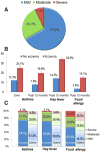Association between severe eczema in children and multiple comorbid conditions and increased healthcare utilization
- PMID: 23773154
- PMCID: PMC4397968
- DOI: 10.1111/pai.12095
Association between severe eczema in children and multiple comorbid conditions and increased healthcare utilization
Abstract
Background: Atopic dermatitis (AD) is associated with multiple comorbid conditions, such as asthma and food allergy. We sought to determine the impact of eczema severity on the development of these disorders and other non-atopic comorbidities in AD.
Methods: We used the 2007 National Survey of Children's Health, a prospective questionnaire-based study of a nationally representative sample of 91,642 children aged 0-17 yr. Prevalence and severity of eczema, asthma, hay fever and food allergy, sleep impairment, healthcare utilization, recurrent ear infections, and visual and dental problems were determined.
Results: In general, more severe eczema is correlated with poorer overall health, impaired sleep, and increased healthcare utilization, including seeing a specialist, compared with children with mild or moderate disease (Rao-Scott chi-squared test, p < 0.0001). Severe eczema was associated with a higher prevalence of comorbid chronic health disorders, including asthma, hay fever, and food allergies (p < 0.0001). In addition, the severity of eczema was directly related to the severity of the comorbidities. These associations remained significant in multivariate logistic regression models that included age, sex, and race/ethnicity. Severe eczema was also associated with recent dental problems, including bleeding gums (p < 0.0001), toothache (p = 0.0004), but not broken teeth (p = 0.04) or tooth decay (p = 0.13).
Conclusions: These data indicate that severe eczema is associated with multiple comorbid chronic health disorders, impaired overall health, and increased healthcare utilization. Further, these data suggest that children with eczema are at risk of decreased oral health. Future studies are warranted to verify this novel association.
Keywords: asthma; atopic; atopic dermatitis; comorbidities; eczema prevalence; eczema severity; epidemiology; food allergies; hay fever; healthcare utilization; rhinoconjunctivitis.
© 2013 John Wiley & Sons A/S. Published by John Wiley & Sons Ltd.
Conflict of interest statement
Figures

References
-
- Besnier E. Premiere note et observations preliminaires pour servir d'introduction a l'etude diathesques. Annales de Dermatologie et de Syphiligraphie. 1892;4:634.
-
- De Benedetto A, Agnihothri R, McGirt LY, Bankova LG, Beck LA. Atopic dermatitis: a disease caused by innate immune defects? J Invest Dermatol. 2009;129:14–30. - PubMed
-
- Blumberg SJ, Foster EB, Frasier AM, et al. Vital Health Stat 1. Vol. 55. National Center for Health Statistics; 2012. Design and Operation of the National Survey of Children's Health, 2007; pp. 1–149. - PubMed
-
- Benjamini Y, Hochberg Y. Controlling the false discovery rate - a practical and powerful approach to multiple testing. J R Stat Soc Series B Stat Methodol. 1995;57:289–300.
-
- Worldwide variation in prevalence of symptoms of asthma, allergic rhinoconjunctivitis, and atopic eczema: ISAAC. The International Study of Asthma and Allergies in Childhood (ISAAC) Steering Committee. Lancet. 1998;351:1225–32. - PubMed
Publication types
MeSH terms
Grants and funding
LinkOut - more resources
Full Text Sources
Other Literature Sources
Medical

